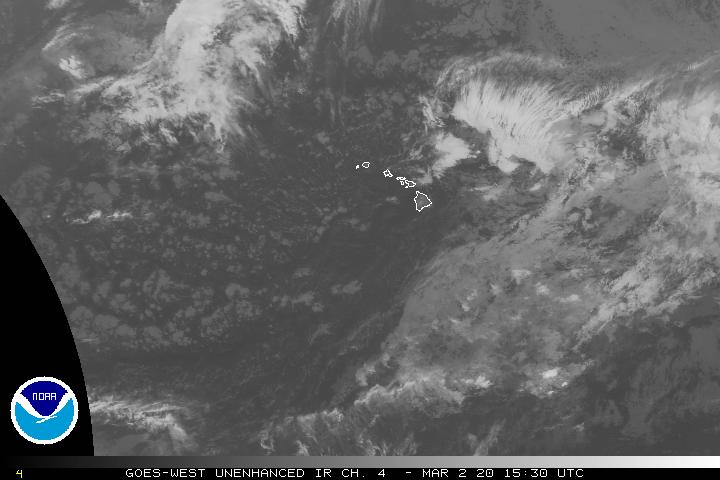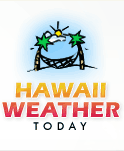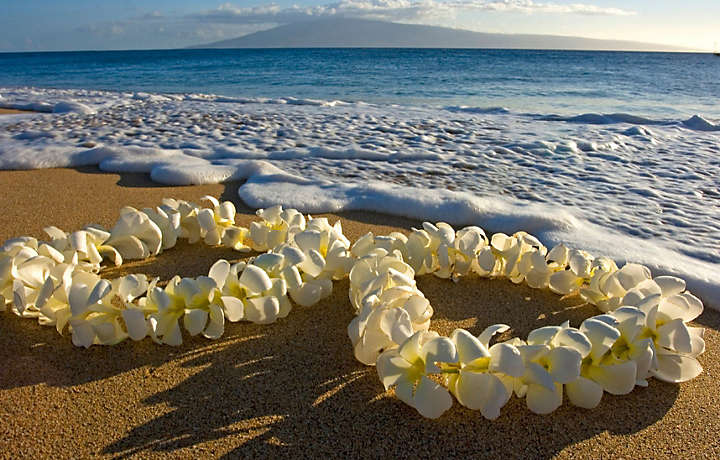Air Temperatures – The following high temperatures (F) were recorded across the state of Hawaii Friday…along with the low temperatures Friday:
73 – 61 Lihue, Kauai – tied the low max record for the date Friday
79 – 67 Honolulu, Oahu
76 – 66 Molokai
79 – 69 Kahului AP, Maui
81 – 66 Kailua Kona
78 – 62 Hilo AP, Hawaii
Here are the latest 24-hour precipitation totals (inches) for each of the islands as of Friday evening:
0.20 Kilohana, Kauai
0.47 Tunnel RG, Oahu
0.61 Molokai
0.00 Lanai
0.02 Kahoolawe
0.81 West Wailuaiki, Maui
0.51 Kamuela, Big Island
The following numbers represent the strongest wind gusts (mph) as of Friday evening:
16 Puu Lua, Kauai
33 Kuaokala, Oahu
25 Molokai
35 Lanai
39 Kahoolawe
25 Kapalua, Maui
33 Kealakomo, Big Island
Hawaii’s Mountains – Here’s a link to the live webcam on the summit of our tallest mountain Mauna Kea (nearly 13,800 feet high) on the Big Island of Hawaii. Here’s the webcam for the Haleakala Crater on Maui. These webcams are available during the daylight hours here in the islands, and at night whenever there’s a big moon shining down. Also, at night you will be able to see the stars — and the sunrise and sunset too — depending upon weather conditions.
Aloha Paragraphs

High pressure north, storms well north…a cold front north

Deep clouds east of the state

Just a few showers – Looping image
Small Craft Advisory…coasts and channels statewide except leeward Oahu
High Surf Advisory…north and west shores of Kauai, and north shores of Oahu, Molokai, Maui and the Big Island
~~~ Hawaii Weather Narrative ~~~
Christmas Day forecast: Trades with off and on windward showers
Broad Brush Overview: Cool and relatively dry air continues to move over the island chain, with light showers limited mainly to windward areas. High pressure will remain north of the islands over the Christmas holiday weekend, keeping light to moderate trades in place and showers primarily over windward and mountain areas. The next weather system will likely bring an increase in showers to the state towards the middle of next week.
Details: A large swath of cool and dry north-northeasterly winds continues to spread over us, as a weakening cold front east of the state continues to move away. High pressure well northwest of the islands, and a surface low east of the Big Island, will support moderately strong winds, with locally stronger gusts in the windier channels. Satellite imagery shows the back edge of overcast layered clouds, sliding farther east of the Big island. Shower coverage favors windward areas, and over the nearby ocean.
High pressure will build eastward to the north of the state, shifting locally breezy north-northeast winds into a more typical northeasterly trade wind direction. A ridge of high pressure will remain north of the state, keeping light to moderate trades in place across the island chain. The atmosphere is expected to slowly moisten up as the trades, along with some old frontal remnants, get caught up within the trade wind flow. We should see an increase in trade wind showers particularly late Sunday through Christmas Day…primarily for windward and mountain areas.
Looking Further Ahead: The models go on to show a cold front approaching from the northwest Monday night and Tuesday, then sweeping down the island chain either Tuesday or Wednesday, with high pressure then building north of the islands during the latter part of next week.
Here’s a wind profile of the Pacific Ocean – Closer view of the islands / Here’s the vog forecast animation / Here’s the latest weather map
Marine environment details: A north-northwest swell arriving Saturday may bring at or near advisory level surf for the north facing shores. This swell is expected to peak Saturday night then decline Sunday. A slightly larger north-northwest swell will arrive next week Wednesday…likely resulting in advisory level surf for the north facing shores.
World-wide Tropical Cyclone activity
>>> Here’s the latest PDC Weather Wall Presentation, covering Tropical Storm 33W (Tembin)
![]()
>>> Atlantic Ocean:
>>> Caribbean Sea:
>>> Gulf of Mexico:
Here’s a satellite image of the Caribbean Sea…and the Gulf of Mexico
Here’s the link to the National Hurricane Center (NHC)
>>> Eastern Pacific:
Here’s a wide satellite image that covers the entire area between Mexico, out through the central Pacific…to the International Dateline.
Here’s the link to the National Hurricane Center (NHC)
>>> Central Pacific:
Here’s a link to the Central Pacific Hurricane Center (CPHC)
>>> Northwest Pacific Ocean:
Tropical Storm 33W (Tembin) remains active, here’s a graphical track map…and a satellite image
>>> North and South Indian Oceans / Arabian Sea: No active tropical cyclones
Here’s a link to the Joint Typhoon Warning Center (JTWC)
Interesting: Humidity May Prove Breaking Point for Some Areas as Temperatures Rise, Says Study – Climate scientists say that killer heat waves will become increasingly prevalent in many regions as climate warms. However, most projections leave out a major factor that could worsen things: humidity, which can greatly magnify the effects of heat alone. Now, a new global study projects that in coming decades the effects of high humidity in many areas will dramatically increase. At times, they may surpass humans’ ability to work or, in some cases, even survive. Health and economies would suffer, especially in regions where people work outside and have little access to air conditioning. Potentially affected regions include large swaths of the already muggy southeastern United States, the Amazon, western and central Africa, southern areas of the Mideast and Arabian peninsula, northern India and eastern China.
“The conditions we’re talking about basically never occur now—people in most places have never experienced them,” said lead author Ethan Coffel, a graduate student at Columbia University’s Lamont-Doherty Earth Observatory. “But they’re projected to occur close to the end of the century.” The study will appears this week in the journal Environmental Research Letters.
Warming climate is projected to make many now-dry areas dryer, in part by changing precipitation patterns. But by the same token, as global temperatures rise, the atmosphere can hold more water vapor. That means chronically humid areas located along coasts or otherwise hooked into humid-weather patterns may only get more so. And, as many people know, muggy heat is more oppressive than the “dry” kind. That is because humans and other mammals cool their bodies by sweating; sweat evaporates off the skin into the air, taking the excess heat with it. It works nicely in the desert. But when the air is already crowded with moisture—think muggiest days of summer in the city–evaporation off the skin slows down, and eventually becomes impossible. When this cooling process halts, one’s core body temperature rises beyond the narrow tolerable range. Absent air conditioning, organs strain and then start to fail. The results are lethargy, sickness and, in the worst conditions, death.
Using global climate models, the researchers in the new study mapped current and projected future “wet bulb” temperatures, which reflect the combined effects of heat and humidity. (The measurement is made by draping a water-saturated cloth over the bulb of a conventional thermometer; it does not correspond directly to air temperature alone.) The study found that by the 2070s, high wet-bulb readings that now occur maybe only once a year could prevail 100 to 250 days of the year in some parts of the tropics. In the southeast United States, wet-bulb temperatures now sometimes reach an already oppressive 29 or 30 degrees Celsius; by the 2070s or 2080s, such weather could occur 25 to 40 days each year, say the researchers.
Lab experiments have shown wet-bulb readings of 32 degrees Celsius are the threshold beyond which many people would have trouble carrying out normal activities outside. This level is rarely reached anywhere today. But the study projects that by the 2070s or 2080s the mark could be reached one or two days a year in the U.S. southeast, and three to five days in parts of South America, Africa, India and China. Worldwide, hundreds of millions of people would suffer. The hardest-hit area in terms of human impact, the researchers say, will probably be densely populated northeastern India.
“Lots of people would crumble well before you reach wet-bulb temperatures of 32 C, or anything close,” said coauthor Radley Horton, a climate scientist at Lamont-Doherty. “They’d run into terrible problems.” Horton said the results could be “transformative” for all areas of human endeavor—“economy, agriculture, military, recreation.”
The study projects that some parts of the southern Mideast and northern India may even sometimes hit 35 wet-bulb degrees Celsius by late century—equal to the human skin temperature, and the theoretical limit at which people will die within hours without artificial cooling. Using a related combined heat/humidity measure, the so-called heat index, this would be the equivalent of nearly 170 degrees Fahrenheit of “dry” heat. But the heat index, invented in the 1970s to measure the “real feel” of moist summer weather, actually ends at 136; anything above that is literally off the chart. On the bright side, the paper says that if nations can substantially cut greenhouse-gas emissions in the next few decades, the worst effects could be avoided.
Only a few weather events like those projected have ever been recorded. Most recent was in Iran’s Bandar Mahshahr, on July 31, 2015. The city of more than 100,000 sits along the Persian Gulf, where seawater can warm into the 90s Fahrenheit, and offshore winds blow moisture onto land. On that day, the “dry” air temperature alone was 115 degrees Fahrenheit; saturated with moisture, the air’s wet bulb reading neared the 35 C fatal limit, translating to a heat index of 165 Fahrenheit.
Bandar Mahshahr’s infrastructure is good and electricity cheap, so residents reported adapting by staying in air-conditioned buildings and vehicles, and showering after brief ventures outside. But this may not be an option in other vulnerable places, where many people don’t have middle-class luxuries.
“It’s not just about the heat, or the number of people. It’s about how many people are poor, how many are old, who has to go outside to work, who has air conditioning,” said study coauthor Alex de Sherbinin of Columbia’s Center for International Earth Science Information Network. De Sherbinin said that even if the weather does not kill people outright or stop all activity, the necessity of working on farms or in other outdoor pursuits in such conditions can bring chronic kidney problems and other damaging health effects. “Obviously, the tropics will suffer the greatest,” he said. Questions of how human infrastructure or natural ecosystems might be affected are almost completely unexplored, he said.
Only a handful of previous studies have looked at the humidity issue in relation to climate change. It was in 2010 that a paper in the Proceedings of the National Academy of Sciences proposed the 35-degree survivability limit. In 2015, researchers published a paper in the journal Nature Climate Change that mapped areas in the southern Mideast and Persian Gulf regions as vulnerable to extreme conditions. There was another this year in the journal Science Advances, zeroing in on the densely populated, low-lying Ganges and Indus river basins. The new study builds on this earlier research, extending the projections globally using a variety of climate models and taking into account future population growth.
Elfatih Eltahir, a professor of hydrology and climate at the Massachusetts Institute of Technology who has studied the issue in the Mideast and Asia, said the new study “is an important paper which emphasizes the need to consider both temperature and humidity in defining heat stress.”
Climate scientist Steven Sherwood of the University of New South Wales, who proposed the 35-degree survivability limit, said he was skeptical that this threshold could be reached as soon as the researchers say. Regardless, he said, “the basic point stands.” Unless greenhouse emissions are cut, “we move toward a world where heat stress is a vastly greater problem than it has been in the rest of human history. The effects will fall hardest on hot and humid regions.”













 Email Glenn James:
Email Glenn James:
Jeff King Says:
Mele Kalikimaka Hoaloha,
The solstice has significance much closer to home as well. The ancient Koi’ei’e fishpond at Kalepolepo (fronting the Whale Sanctuary on South Kihei road) was built on a celestial compass countless years ago. At each equinox the sun sets exactly perpendicular to the outer wall. At the Winter solstice, when one stands on the beach at the north end of the wall, the sun sets directly in line with the wall. The inverse happens along the south wall at the Summer Solstice. You can still catch it for several days – understanding that it will begin the march northward at each sunset.
Merry Christmas to you and your mom. Mahalo nui loa for all you do. I try to never miss a day.
~~~ Hi Jeff, thanks so much for the interesting added information about the Solstice here closer to home!
Thanks for your Christmas wishes, and yes, I am here in Long Beach with my Mom for the holiday…as I was for Thanksgiving. I’ve traveled so much this past year! Next I’m up to Sonoma County for New Years, and then back to Maui on the 11th. My life is different now, as I’m spending more and more time with my 95 year old Mom.
Happy Holiday’s to you and yours as well Jeff.
Aloha, Glenn
Douglas MacDougal Says:
Aloha Glen
Here in Sydney at this time of the year…. there seem to many thousands of people appreciating the spiritual significance of the Summer Solstice…..and they are all lying on Bondi Beach from every corner of the globe!
Happy Holidays, thanks for your wonderful, informative website.
Douglas
~~~ Hi Douglas, good to hear from you down there in Sydney, where the official start of summer just happened!
I haven’t been to Bondi Beach, or anywhere in Australia yet, although I hear its a wonderful country…and a great beach!
You are very welcome, I greatly enjoy keeping this fun website alive and well…with no plans to discontinue it.
Happy Holiday’s
Aloha, Glenn
David Adam Says:
Hi Glenn, Nice rap on the Solstice…i.e. “The Cosmic New Year.. The Makahiki was done around this although lasted around four months. The Hawaiians we’re very in tune with nature’s cycles and this time if year was especially festive…one big New Year’s Party (Makahiki). Strange how the Solstice is the actual New Year but we end up with Xmas…???? Oh Well…I do wish you and your Mom a very happy and festive time. Heartfelt warmth your way..Aloha Nui…p.s.and Mahalo Nui for a year of your fine site work.
~~~ Hi David, thanks for being an ongoing reader, and for sharing your appreciation through the last year!
Happy Holidays!
Aloha, Glenn
Joanne Vasquez Says:
Love your website, Glenn. Happy holidays to you.
We are in Haiku and wondering if there is a website where we can see rainfall totals for various parts of the island for last 24h and over various time periods.
Thanks
~~~ Hi Joanne, I love that you love my website!
Happy Holiday’s to you and yours…as well.
As for rainfall totals…please see here:
http://www.prh.noaa.gov/hnl/hydro/daily_archive/HRS_archive.php
Aloha, Glenn